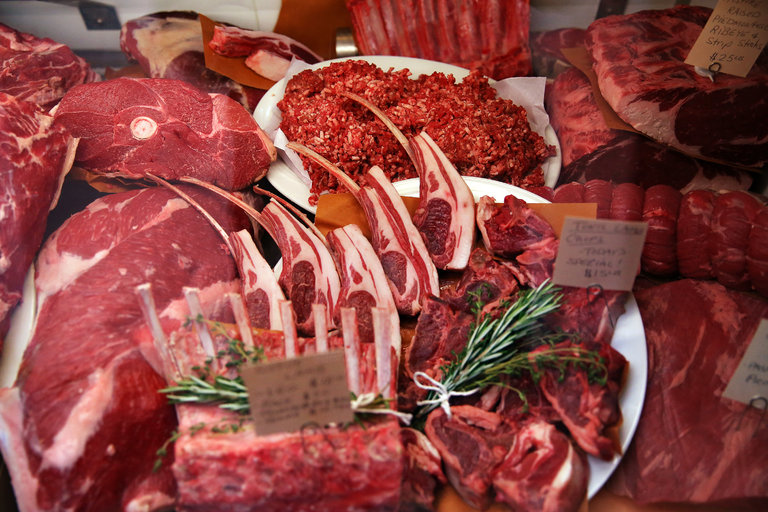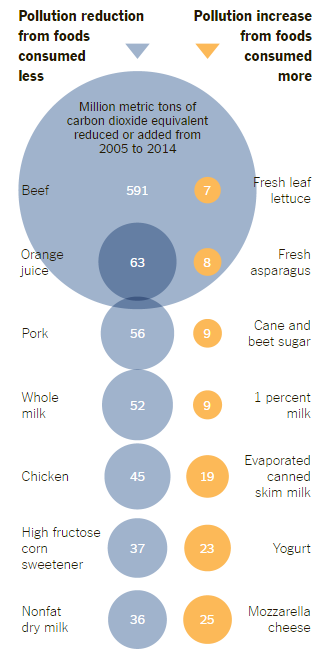
Date: 2024-04-29 Page is: DBtxt003.php txt00013356
Food / US Trends
Less Meat
Americans Ate 19% Less Beef From ’05 to ’14, Report Says
Burgess COMMENTARY
Peter Burgess
FOOD ... Americans Ate 19% Less Beef From ’05 to ’14, Report Says

Credit Nicole Bengiveno/The New York Times
The last decade or so has brought ample evidence that Americans are gradually changing their diets, driven by health concerns and other factors.
But a new study points to one change that is starker than many have thought: Americans cut their beef consumption by 19 percent — nearly one-fifth — in the years from 2005 to 2014, according to research released on Wednesday by the Natural Resources Defense Council.
|
CARBON EMISSIONS from Meat Production
| Open PDF ... NRDC-less-beef-less-carbon-report-2017 |
 Pollution reduction from foods consumed less
Pollution increase from foods consumed more
Million metric tons of carbon dioxide equivalent reduced or added from 2005 to 2014
Fresh leaf lettuce Beef 591 7
Orange juice Fresh asparagus 8 63
Cane and beet sugar Pork 56 9
Whole milk 1 percent milk 52 9
Evaporated
canned
skim milk
Chicken
45
19
High fructose
corn
sweetener
Yogurt
37
23
Mozzarella
cheese
Nonfat
dry milk
36
25
Canned
tomatoes
Other Italian
cheese
28
25
Frozen
potatoes
Butter
27
29
Fresh head
lettuce
American
cheese
20
30
Source: Natural Resources Defense Council
By The New York Times
“Whether we realize it or not, Americans have been fighting greenhouse gas emissions with their forks,” said Sujatha Bergen, a policy specialist in the Natural Resources Defense Council’s food and agriculture program.
The council did not ask Americans why they were eating differently. But Ms. Bergen said that greater attention to how food affected health and well-being — rather than awareness of the environmental impact — was probably driving the decline in beef consumption.
Asked what prompted them to eat less beef, 37 percent of consumers surveyed cited its price as the No. 1 reason in research published in January by Mintel, a consumer research firm. Thirty-five percent of the respondents said they were eating more protein from other sources, like chicken or tofu. But more than a quarter ascribed the change to their concern about cholesterol and saturated fats.
The National Cattlemen’s Beef Association, a trade group for beef producers, said the main reason for beef’s decline was a reduced supply of meat, because of increased exports: The United States was a net exporter of beef from 2010 to 2013.
Another reason was increased competition from other meats like chicken and pork, the group said. Droughts during the period covered by the defense council report also cut into the beef supply, said Daren Williams, a spokesman for the organization. Facing higher feed prices, ranchers cut their production, and the price of beef rose.
It takes two years on average for a cow to reach slaughter size, which explains why the nation’s cattle stock is just now showing recovery, the association said. The industry group predicts a recovery in beef consumption, as does the Agriculture Department.
NYT FoodFood News
Follow On
The beef association said it was “fallacious” to draw a link between beef consumption and automobile emissions. Sara Place, the group’s senior director of sustainable beef production research, said consumers could do more to reduce carbon emissions by throwing away less food, particularly fruits and vegetables, than by eating less beef.
The beef industry has reduced its carbon footprint, Dr. Place said, with improvements in cattle genetics and production methods. One-third fewer cows were needed in 2015 to produce the same amount of beef produced in 1975, she said.
“Our cattle numbers have gone down over a 40-year period, reducing carbon emissions and our carbon footprint,” she said.
Consumption of all meats, taken together, has been falling from a peak in 2007, according to the Agriculture Department. Per capita consumption of beef topped out in 1976, but it remained America’s favorite meat until the mid-1990s, when it was surpassed by chicken.
The new report shows declines in other food, like orange juice and frozen potatoes, that have notable carbon footprints.
108
COMMENTS
But of all the foods Americans eat, beef has by far the biggest footprint. The feeds given to cattle are grown with petroleum-based fertilizers, and the animals’ digestive systems produce methane, a pollutant 25 times as damaging to the environment as carbon dioxide. The manure, which is spread on fields or collected in large tanks, also emits greenhouse gases, said Ms. Bergen of the Natural Resources Defense Council.
A drop in orange juice consumption generated the second-largest reduction in greenhouse gases linked to a food, eliminating the equivalent of some 63 million metric tons of carbon dioxide from the environment — or roughly 10 percent of the reduction attributable to eating less beef.
Correction: March 29, 2017
A chart last Wednesday with an article about a new report showing that American beef consumption fell 19 percent from 2005 to 2014 misstated the name of the environmental group that produced the study. It is the Natural Resources Defense Council (not National). The article misstated the potency of methane as a pollutant. It is 25 times more damaging to the environment than carbon dioxide, not 25 percent. The article and chart, using information from the council, also misstated the equivalent amounts of carbon dioxide; they were measured in metric tons, not megatons.
A version of this article appears in print on March 22, 2017, on Page D4 of the New York edition with the headline: Americans Ate 19% Less Beef Over Decade, Study Says. Order Reprints| Tod
COMMENTS
brublr April 4, 2017
Friends don't eat friends
Henrik Blunck March 27, 2017
It seems rather funny that people have subscribed to the measurements of animal farts without any critical thinking whatsoever. Cows have...
Niklas Dellby March 27, 2017
Why is there a picture of lamb while lambasting beef?
Pollution reduction from foods consumed less
Pollution increase from foods consumed more
Million metric tons of carbon dioxide equivalent reduced or added from 2005 to 2014
Fresh leaf lettuce Beef 591 7
Orange juice Fresh asparagus 8 63
Cane and beet sugar Pork 56 9
Whole milk 1 percent milk 52 9
Evaporated
canned
skim milk
Chicken
45
19
High fructose
corn
sweetener
Yogurt
37
23
Mozzarella
cheese
Nonfat
dry milk
36
25
Canned
tomatoes
Other Italian
cheese
28
25
Frozen
potatoes
Butter
27
29
Fresh head
lettuce
American
cheese
20
30
Source: Natural Resources Defense Council
By The New York Times
“Whether we realize it or not, Americans have been fighting greenhouse gas emissions with their forks,” said Sujatha Bergen, a policy specialist in the Natural Resources Defense Council’s food and agriculture program.
The council did not ask Americans why they were eating differently. But Ms. Bergen said that greater attention to how food affected health and well-being — rather than awareness of the environmental impact — was probably driving the decline in beef consumption.
Asked what prompted them to eat less beef, 37 percent of consumers surveyed cited its price as the No. 1 reason in research published in January by Mintel, a consumer research firm. Thirty-five percent of the respondents said they were eating more protein from other sources, like chicken or tofu. But more than a quarter ascribed the change to their concern about cholesterol and saturated fats.
The National Cattlemen’s Beef Association, a trade group for beef producers, said the main reason for beef’s decline was a reduced supply of meat, because of increased exports: The United States was a net exporter of beef from 2010 to 2013.
Another reason was increased competition from other meats like chicken and pork, the group said. Droughts during the period covered by the defense council report also cut into the beef supply, said Daren Williams, a spokesman for the organization. Facing higher feed prices, ranchers cut their production, and the price of beef rose.
It takes two years on average for a cow to reach slaughter size, which explains why the nation’s cattle stock is just now showing recovery, the association said. The industry group predicts a recovery in beef consumption, as does the Agriculture Department.
NYT FoodFood News
Follow On
The beef association said it was “fallacious” to draw a link between beef consumption and automobile emissions. Sara Place, the group’s senior director of sustainable beef production research, said consumers could do more to reduce carbon emissions by throwing away less food, particularly fruits and vegetables, than by eating less beef.
The beef industry has reduced its carbon footprint, Dr. Place said, with improvements in cattle genetics and production methods. One-third fewer cows were needed in 2015 to produce the same amount of beef produced in 1975, she said.
“Our cattle numbers have gone down over a 40-year period, reducing carbon emissions and our carbon footprint,” she said.
Consumption of all meats, taken together, has been falling from a peak in 2007, according to the Agriculture Department. Per capita consumption of beef topped out in 1976, but it remained America’s favorite meat until the mid-1990s, when it was surpassed by chicken.
The new report shows declines in other food, like orange juice and frozen potatoes, that have notable carbon footprints.
108
COMMENTS
But of all the foods Americans eat, beef has by far the biggest footprint. The feeds given to cattle are grown with petroleum-based fertilizers, and the animals’ digestive systems produce methane, a pollutant 25 times as damaging to the environment as carbon dioxide. The manure, which is spread on fields or collected in large tanks, also emits greenhouse gases, said Ms. Bergen of the Natural Resources Defense Council.
A drop in orange juice consumption generated the second-largest reduction in greenhouse gases linked to a food, eliminating the equivalent of some 63 million metric tons of carbon dioxide from the environment — or roughly 10 percent of the reduction attributable to eating less beef.
Correction: March 29, 2017
A chart last Wednesday with an article about a new report showing that American beef consumption fell 19 percent from 2005 to 2014 misstated the name of the environmental group that produced the study. It is the Natural Resources Defense Council (not National). The article misstated the potency of methane as a pollutant. It is 25 times more damaging to the environment than carbon dioxide, not 25 percent. The article and chart, using information from the council, also misstated the equivalent amounts of carbon dioxide; they were measured in metric tons, not megatons.
A version of this article appears in print on March 22, 2017, on Page D4 of the New York edition with the headline: Americans Ate 19% Less Beef Over Decade, Study Says. Order Reprints| Tod
COMMENTS
brublr April 4, 2017
Friends don't eat friends
Henrik Blunck March 27, 2017
It seems rather funny that people have subscribed to the measurements of animal farts without any critical thinking whatsoever. Cows have...
Niklas Dellby March 27, 2017
Why is there a picture of lamb while lambasting beef?